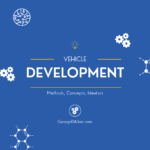Develop the Core of Object Classification: New Sensing Tech

Develop Fundamentals of Object Classification
Enhancing Vehicle Safety: Understanding Object Classification in Passive Safety Features
Continuing with Occupant Sensing System development, we delve into the critical aspect of vehicle safety: Object Classification for Passive Safety Features. Sequentially, the discussion revolves around the development of the Occupant Sensing Classification function, with a specific focus on Object Classification.
To begin with, it’s imperative to establish a foundational understanding of non-living objects within the vehicle. As occupants enter the Field of View, data acquisition becomes crucial. However, it’s common for occupants to bring various objects into the vehicle. Therefore, there arises a necessity to recognize and facilitate the Object Classification (algorithm development) discussion for the applications in technology.
Moving forward, we explore the categories of objects that require attention from a Passive Safety standpoint. By addressing the fundamental definition and development of Object Classification, we pave the way for enhanced safety measures within vehicles.
References:
Development of the Presence Detection Function: https://georgedallen.com/develop-presence-detection-new-occupant-sensing-tech/
Passive Safety Features: https://georgedallen.com/evolution-of-occupant-safety-systems-in-the-vehicle-development/
Object Classification: Key Categories for Vehicle Safety
In the realm of Object Classification for vehicle safety, it’s crucial to identify and address various categories of objects. These categories play a pivotal role in the development of specific requirements tailored for Passive Safety Features.
Firstly, attention is drawn to large non-living items that might be mistaken for living beings due to their size or shape. Additionally, verifying the absence of living beings within cargo spaces is imperative for ensuring safety. Furthermore, considerations extend to addressing other driving features’ requirements concerning different items.
Consequently, special cases also warrant attention, such as children’s car seats and adult restraints (like handicap wheelchairs) utilized across different vehicles. Moreover, these necessitate unique classification methodologies to ensure optimal safety measures.
Furthermore, within the Automotive Industry, efforts are underway to tackle the detection and classification of smaller items essential to passengers, including phones, computers, briefcases, and small bags. Addressing these items aligns with customer functional requirements and enhances overall safety protocols.
Moreover, it’s worth noting that the recognition of Child Restraint Systems (CRS) will be discussed separately to ensure comprehensive coverage of algorithm development.
The Significance of Object Classification Capabilities
In the pursuit of advanced vehicle safety measures, the significance of Object Classification capabilities cannot be overstated. Consequently, initial system capabilities to detect and classify living beings serve as a foundation for recognizing non-living objects based on analyzed datasets. However, it’s crucial to understand that object classification is a distinct and different function, requiring specific technological approaches.
Generally, developing system and subsystem requirements involves considering various factors such as vehicle door opening parameters, available seat volume, and cargo door capacity. In addition, this is particularly crucial for large objects that may require securing to prevent shifting, especially in scenarios like front-seat placement where airbag deployment is a concern.
Furthermore, addressing the classification of smaller items like phones, computers, and purses presents unique challenges. Consequently, each item necessitates its own dataset for recognition, given the vast array of possibilities. Moreover, the difficulty here stems from the fact that the list of these items is potentially endless, this particular utilization of the computational powers will have to be based on the “needs” from the high-level requirements.
Sequentially, the logic governing Object Classification information must be tailored to each requesting Passive Safety Feature. For instance, if a large object, like a bag of golf clubs, is placed on the front passenger seat, protocols must determine whether it needs to be secured or repositioned to ensure occupant safety without compromise.
Advancing Vehicle Safety with AI: Exploring Object Classification
In the realm of vehicle safety, leveraging AI tools for Object Classification holds immense potential. In addition, by harnessing AI capabilities, the recognition of items within the vehicle can be significantly optimized, paving the way for enhanced Data Acquisition algorithms. Moreover, this approach facilitates sequential data processing, complemented by machine learning, to effectively classify objects within the Field of View.
Furthermore, integrating AI applications with Simulation technology, particularly Virtualization sets, offers a twofold advantage. Additionally, not only does it contribute to the development of safer, high-quality products, but it also enables simulation and validation of desired performance outcomes. Consequently, this synergy between AI and Simulation technology streamlines the process of crafting and verifying Object Classification algorithms.
Finally, the integration of AI tools presents an unparalleled opportunity to refine initial requirements and execute algorithms with precision and efficiency. In addition, by embracing AI in this manner, Object Classification capabilities can be enhanced, driving significant advancements in vehicle safety and functionality.
References:
Development of the Prerequisites: https://georgedallen.com/wp-admin/post.php?post=14241&action=edit
Virtual Development: https://georgedallen.com/virtual-development-embracing-tomorrow-today/
“Virtualization” definition: https://en.wikipedia.org/wiki/Virtualization
Conclusion: Achieving Optimal Object Classification
In conclusion, Object Classification for Passive Safety stands as a pivotal aspect of Occupant Sensing System development. Consequently, each Object Classification standard necessitates dedicated development projects to ensure alignment with decision-making criteria. Overall, Signal outputs for the library of Classified Objects must be meticulously developed to enhance safety protocols further.
Highlighting the significance of special cases, such as car seat usage, underscores the importance of aligning development projects with Infant classification needs, including scenarios where infants are seated in car seats, and just simply placed on the vehicle seat. Generally, this approach ensures comprehensive safety measures for car seats utilization.
Ultimately, the system’s capability to classify objects alongside detecting and classifying occupants signifies a significant stride toward fulfilling Passive Safety goals comprehensively. Consequently, this evolutionary journey underscores the ongoing commitment to advancing vehicle safety through refined Object Classification functionalities.
Reference to Systems Engineering Method: https://georgedallen.com/systems-v-model-strategy-in-automotive-design/
About George D. Allen Consulting:
George D. Allen Consulting is a pioneering force in driving engineering excellence and innovation within the automotive industry. Led by George D. Allen, a seasoned engineering specialist with an illustrious background in occupant safety and systems development, the company is committed to revolutionizing engineering practices for businesses on the cusp of automotive technology. With a proven track record, tailored solutions, and an unwavering commitment to staying ahead of industry trends, George D. Allen Consulting partners with organizations to create a safer, smarter, and more innovative future. For more information, visit www.GeorgeDAllen.com.
Contact:
Website: www.GeorgeDAllen.com
Email: inquiry@GeorgeDAllen.com
Phone: 248-509-4188
Unlock your engineering potential today. Connect with us for a consultation.


